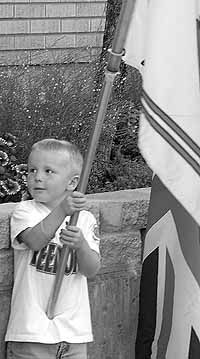“Ethnic and cultural diversity has shaped the Carbon County area over the past hundred years more deeply than in Utah’s other 28 counties,” so said Warren Neil and Grady McEvoy as they address a large crowd last Thursday during opening ceremonies of International Days.
Tracing the history of the area from Ronald Watt’s book, “A History of Carbon County,” they told the crowd that creating this diversity were immigrants from all over the world, including Asia, the Middle East, Europe, the British Isles, Scandinavia, the Balkans, Greece, Italy, France and Mexico. “They made their homes in Carbon County and contributed to all aspects of community life, producing a heritage of tolerance and acceptance that some have defined as the finest of the Carbon county experience.”
“Learning to accept and appreciate the values and heritage of one another proved to be crucial to this diversity, which is now viewed as a strength. Even today, we celebrate the addition of each new nationality to our community,” they continued.
The popular flag ceremony began with the Native Americans, who populated this area prior to the arrival of the explorers and settlers included the Ute, Piute and Navajo. “Theirs is a story of survival in the arid deserts allocated to them by the government of the united States. Their culture brings a heritage of peace and beauty.”
The ceremony continued with each group of immigrant people coming into the Price River Valley, including those from northern Europe.
Many of these early Europeans were members of the Mormon church and came to Carbon County because they were experienced coal miners.
The flags continued to be carried across the stage and represented the Welsh immigrants who began working in the Winter Quarters mine, followed by the Finnish people and later the Northern Italians.
Many French people came, bringing their skills as sheepherders and groups of Hispanic people from the northern provinces of Mexico came to tend the cattle and work in the mines and railroads.
Greeks first arrived in 1904 to work in the mines and by 1910 the Greeks had become one of the dominant ethnic groups in the county.
Southern Slavs, called Austrians, came as railroad workers but quickly switched to coal mining because of the availability of work.
As the narration was read the flags were paraded across the stage. Also recognized were the Japanese immigrants and people from many other countries who migrated to this county including people from Thailand.
“Work brought men of different cultures together, sharing common problems and concerns, and schools brought children of these various peoples together. Gradually in the workplace and in the schools these ehtnic groups came together.”
“Slowly but surely, those who where born in other countries became United States citizens. Today we all stand proudly as Americans, who boast of the diversity which makes Carbon county the unique county,” concluded Neil and McEvoy.
Each year these nationalities are honored during International Days, especially during the opening flag ceremony.
Flags trace area’s diversity

